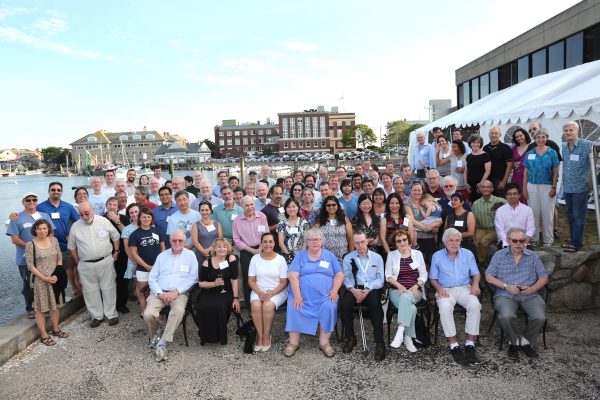A Bright Idea Matures: Grass Lab Celebrates 65th year

What happens when scientific philanthropy meets the brains behind discovery? The Grass Laboratory is born, representing a fruitful cooperation between the Grass Foundation and the Marine Biological Laboratory to train budding neuroscientists.
“The Grass Foundation and the MBL have been intertwined since the 1950’s,” says current foundation President Felix Schweizer of University of California, Los Angeles. “There is a beautiful history of respect, collaboration, and guidance that creates a truly intellectual environment.”
Each summer, 8 to 12 Grass Fellows set up shop at the MBL for 14 weeks, acting as principal investigators and conducting self-designed, cutting-edge research. The fellowship occurs during a formative period in their careers (often during a postdoctoral term), inciting the self-confidence and motivation required to become established scientists.
“The program is designed to allow individuals to conduct independent research for the first time without the supervision of an advisor,” explains MBL Whitman Center Scientist Steve Zottoli of Williams College, a Grass Foundation Life Trustee, past foundation president, and 1978 Grass Fellow. “At the same time, fellows still receive mentorship, advice, and camaraderie from one another and the MBL community.”
In July, the Grass Foundation-MBL partnership celebrated its 65th anniversary. Of the 600 alumni of the Grass Lab, just shy of 100 returned to the MBL for a reunion.
“The overwhelming takeaway from everyone who participated was that the Grass Fellowship was career changing,” says Schweizer. “Most said it not only altered the way they do science, but also the way they see themselves.”
The fellowship's impact on young scientists is considered in detail in a Neuron article by former Grass Lab director Alberto Pereda of Albert Einstein College of Medicine.
Auspicious beginnings
As a non-profit, private foundation promoting research and education in neuroscience, the Grass Foundation was initiated in 1955 with the help of Albert and Ellen Grass. This couple had previously established the Grass Instrument Company, which manufactured EEG machines and other electrophysiological equipment.
Albert and Ellen Grass used the proceeds from their business endeavors to create the Grass Charity Trust, fostering new and exciting research in neurophysiology and related fields. These funds ultimately engendered a lasting affiliation with the MBL, giving rise to the Grass Laboratory Fellowship in 1951—even before the Foundation itself had taken shape.
Harry Grundfest of Columbia University, Stephen Kuffler of Harvard University, and Ichiji Tasaki of the National Institutes of Health—all eminent figures in 20th century neuroscience—played crucial roles in the Grass Lab’s early years, and could be considered its first “directors.” Since that time, hundreds of researchers have completed a Grass Laboratory Fellowship, and many have gone on to make significant contributions to their respective disciplines.
 Current and former Grass Fellows at the 65th reunion dinner at MBL. Credit: Elizabeth F. Armstrong Photography
Current and former Grass Fellows at the 65th reunion dinner at MBL. Credit: Elizabeth F. Armstrong PhotographyA track record of success
For example, the fellowship inspired Ricardo Miledi, a 1955 Grass Fellow, to examine the role of calcium ions in synaptic transmission—leading to the prestigious Royal Medal in 1998 and the Ralph W. Gerard Prize in 2010. Another alumnus, Michael V. L. Bennett, performed one of the first experiments to demonstrate electrical coupling between vertebrate neurons while a fellow in 1958.
More recently, 2014 Grass Fellow Shigeki Watanabe received the 2015 Eppendorf & Science Prize for Neurobiology for devising a novel way to visualize ultrafast processes in neurons. His accomplishments extended earlier innovations in electron microscopy by MBL Whitman Center Scientist Tom Reese of the National Institutes of Health and John Heuser of Washington University in St. Louis.
The list of notable fellows goes on, including two 1979 Grass Fellows: Scott Fraser of the University of Southern California, whose research centers on translational imaging and molecular analyses of intact biological systems, and MBL Whitman Center Scientist George Augustine of Nanyang Technological University, who investigates synaptic function. There’s also 2000 Grass Fellow and current MBL Fellow Melina Hale of University of Chicago, who studies the neurobiology of zebrafish locomotion, as well as 2013 Fellow James Olopade of the University of Ibadan in Nigeria, whose focus is comparative craniofacial anatomy and neuroscience.

Although Grass Fellows disperse far and wide post-program to pursue various research interests, many maintain a lifelong connection to Woods Hole after catching the “MBL bug,” as Schweizer puts it. Case in point, 2003 Grass Fellow Jennifer Morgan is now an associate scientist at the MBL, investigating the molecular underpinnings of neuronal communication.
“The Grass Foundation has provided me with generous support for my research endeavors,” Morgan says. “All of the Grass experiences came at critical, formative times in my scientific career, allowing me to develop and grow as an independent researcher. Moreover, members of the Grass Family have become some of my closest colleagues, collaborators, and friends.”
Zottoli agrees. “One of the factors that sets the Grass Fellowship apart is the environment at the MBL,” he says. “There’s this vibrant energy that can’t be captured on paper; you just have to experience it.”
